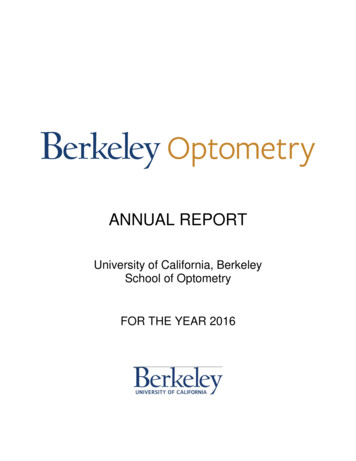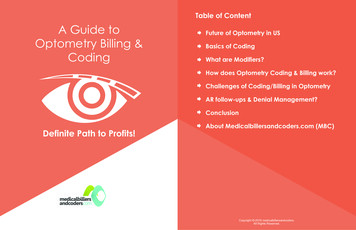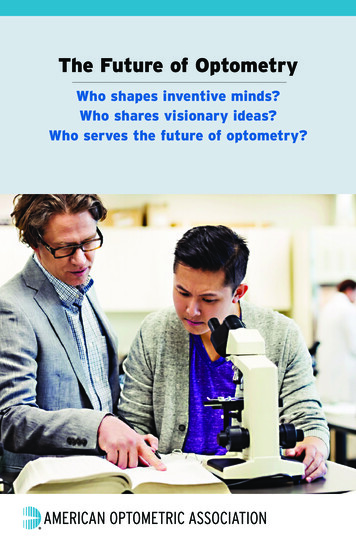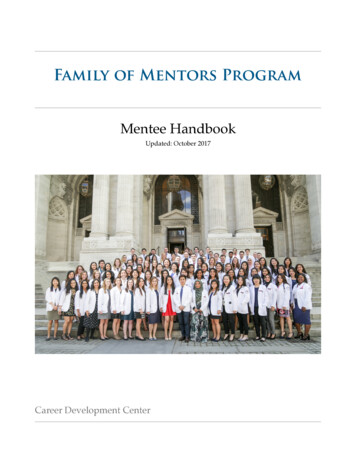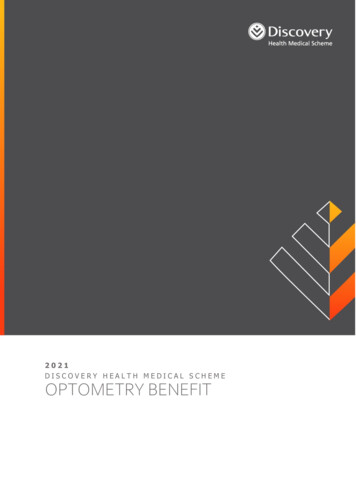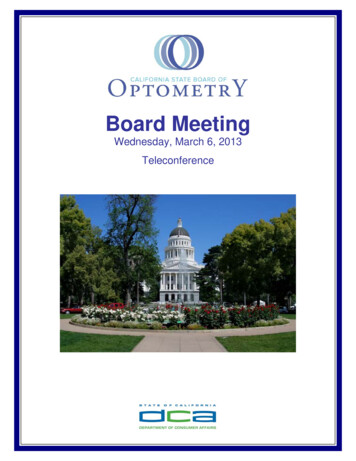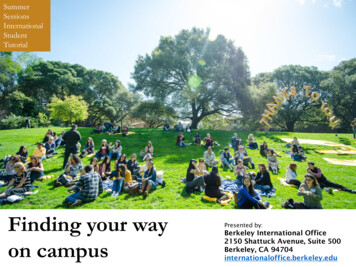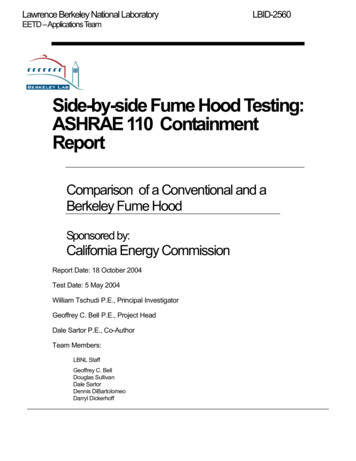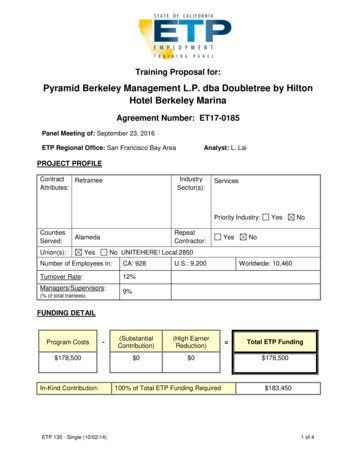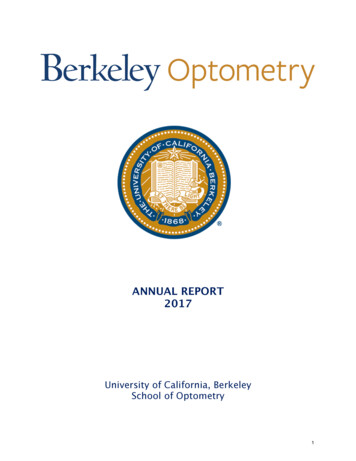
Transcription
ANNUAL REPORT2017University of California, BerkeleySchool of Optometry1
ContentsORG CHART . 3ACADEMIC PROGRAMS: ADMINISTRATION, FACULTY, STUDENTS. 3Administration . 3Faculty and Alumni . 3Optometry Faculty Research . 4Professional Student Performance . 4Residents. 5Vision Science Graduates . 5ADMISSIONS AND STUDENT AFFAIRS OFFICE . 5CONTINUING EDUCATION . 9ONLINE CONTINUING EDUCATION. 13CLINICAL RESEARCH CENTER . 14DEVELOPMENT & EXTERNAL AFFAIRS . 18FONG OPTOMETRY & HEALTH SCIENCES LIBRARY . 19AWARDS AND HONORS . 21OPTOMETRY CLINICS . 22RESIDENCIES . 22SUMMER RESEARCH TRAINING PROGRAMS . 35OPTOMETRIC STUDENT ASSOCIATION . 40VISION SCIENCE . 4722
ORG CHARTACADEMIC PROGRAMS: ADMINISTRATION, FACULTY, STUDENTSAdministrationJohn Flanagan became Dean of the School of Optometry, for a five-year termbeginning June 1, 2014. The prior Dean Dennis Levi returned to being a Professor ofOptometry and Vision Science. Chris Wilmer became Associate Dean for ClinicalAffairs in July 2014 replacing Ed Revelli who retired from the University. Rick VanSluyters remains as Associate Dean for Student Affairs and Gunilla HaegerstromPortnoy remains as Associate Dean for Academic Affairs.Eric Leal left for Washington DC and Monica Porter was appointed as Assistant Deanof Operations and Anna Lim was appointed Assistant Dean of Finance in October2017 and Meg St. John was appointed as Assistant Dean for Admissions and StudentAffairs to replace Sharon Joyce who moved to Utah. Kristen Williams is AssistantDean for Development and Alumni Relations. Eric Craypo is the Director ofCommunications.Faculty and AlumniNo long-time faculty members have retired this last year. Two new faculty membersjoined us officially in July 2016: Assistant Professor Teresa Puthussery, OD, PhD andProfessor Rowland Taylor, PhD. We are currently searching for more full-time tenuretrack faculty and expect to make 1 or 2 appointments in the spring of 2018. TheSchool now has 32 full time clinical faculty members with a total faculty FTE count of73 (including optical faculty members), which translates to 106 people since many33
clinical faculty members are part-time.Faculty member Melanie Mason was President of ACCCOS in 2016 and Sarah Kochik(now a VS graduate student) became president in 2017.Former UCB faculty member Don Sarver was honored as the Alumnus of the Year for2017 at the Alumni Reunion in October 2017. He also retired in 2017 after 46 yearsin practice. Faculty member Ian Bailey received the Mert Flom teaching award from the25-year reunion class.Professor Suzanne Fleiszig received the Max Schapero Memorial Lecture Award fromthe American Academy of Optometry, in 2017 and gave a presentation at theAcademy Annual meeting in Chicago in October 2017.Optometry Faculty ResearchFrom July 1, 2016 through June 30, 2017, optometry faculty members generated 9.1million in direct costs for 47 different projects. Most projects are 3-5 years andfunding was received from various federal agencies (NIH, NSF, DOD) as well as privatefoundations and industry. Basic research accounted for 63% while clinical andtranslational research received 30%. The remaining was for training. This is anoutstanding performance given the difficulty of receiving research funding these days.The NEI T32 Training Grant has been continuously funded for 40 years, and the CoreGrant has been funded for 39 years. The School of Optometry has one other researchtraining grant for optometry students (T35) which is now in year 24. The T32 and T35grants were submitted for competitive renewal in May 2017 and the Core grant wassubmitted for competitive renewal in September 2017.Professional Student performanceOur students continue to do well on the National Board Exams required for licensure.For each of the 3 parts, UCB students perform considerably better than the nationalaverageNBEO PartBerkeleyPass RateNationalPass RateI: Applied Basic SciencerdMarch 2017 (3 year students) Class of 201784.6%62.9%II: Patient Assessment and ManagementthDecember 2016 (4 year students)Class of 201798.3%79.0%III: Clinical SkillsFall 2016-Spring 2017 (4th year students) Class of 201789.1 %77.4%44
ResidentsA high proportion of graduating optometry students apply for and receive a match for furtherresidency training. For 2017, 70% of 33 applicants from the graduating class matched in theORMS round and 5 found positions post-match for a total of 85% of the residency applicantsof the 2017 graduating class placed into residency positions. 57% of the class applied for aresidency position.Vision Science graduatesOver the last 5 years, the Vision Science program has graduated 24 PhD’s and 2 MS students.Four of the PhD’s had prior health science training (OD or MD). The program currently has 42PhD students of which 6 have prior health science training.ADMISSIONS AND STUDENT AFFAIRS OFFICEStaffThe academic year 2017-2018 has been positive, productive, and full of change. Theoffice began the year staffed by Assistant Dean Sharon Joyce, Heather Iwata, Director,Assistant Director, Kait Guthrie, and Carissa Caloud, is the Coordinator of Admissionsand Student Affairs position. We will end the year staffed by Assistant Dean Meg St.John, Associate Director Kait Guthrie, Associate Director Carissa Caloud, and a soonto be hired Coordinator.For prospective and current students, listed below are updates on new and pastinitiatives.Admissions StatisticsWe collected 237 applications for Fall 2018 entry. Our Interview Day is on Saturday,February 3, and we plan to interview approximately 115 candidates. With theintroduction of Multiple Mini-Interviews (MMIs) three years ago, we have the mostholistic file review of all optometric programs. Our quality remains high, as reflectedby the first year Class of 2021, average OAT AA 358 Biology/Chemistry/ Physics(BCP) GPA 3.47 respectively.Ask an AdvisorThe ASAO has continued the “Ask an Advisor” program, which began in spring 2005.“Ask an Advisor” was created to meet the needs of prospective students who want toset up one-on-one appointments to discuss admissions and the application process.The staff has set aside specific days each week when either a phone or in-personadvising session can be arranged. This program continues to be a successful avenuein providing prospective students with information and guidance as they prepare for55
the application process. We have also expanded our website to offer tips and adviceto be a successful applicant.Diversity OutreachOur National Optometric Student Association (NOSA) chapter is thriving. NOSAmembers at Berkeley Optometry continue to host instructional workshops to teachoptometric Spanish and assist with vision screenings in underserved communities.NOSA also organized and presented for the ASAO at summer visits, targetingunderrepresented minority high school and middle school students to learn aboutSTEM fields.National Student Leadership ConferenceThe School of Optometry hosted four groups of 150 high school students from theNational Student Leadership Conference (NSLC) in July and August of 2017. Theconference aims to broaden the horizons of top-notch high school students, fromrising sophomores to seniors, who are interested in careers in health and medicine.Participants listened to an overview of the admissions process at Berkeley Optometry,participated in an interactive presentation on visual illusions and perception, led byVision Science PhD students, and joined activities with current Berkeley Optometrystudents, which included exploring the slit-lamp and testing for eye-dominance.OptomCASLaunched on July 15, 2009, all Optometry applicants now utilize the OptometryCentralized Application Service (OptomCAS). This service, which offers applicants anefficient and convenient way to apply to multiple optometry programs using a singleweb-based application, has been hugely successful for collecting richer data regardingapplicants to OD programs in the United States and Puerto Rico. Additionally, theOptomCAS portal eliminates the need for duplicate transcripts and letters ofrecommendations and provides “real-time” tools for applicants to check the status oftheir applications. All Schools and Colleges of Optometry are participant programs;Optometry is the only health-science program that boasts full participation for allmember schools and colleges.WebAdmitAdmissions applications are now being processed and reviewed through WebAdmit,an extension of the OptomCAS application service that allows Schools and Colleges ofOptometry to process their applications through a secured online portal; the use ofWebAdmit at Berkeley Optometry has simplified the review process and increasedefficiency for our Admissions Committee members. It has also significantly reducedour paper waste.66
Opto-CampIn 2006, the Admissions and Student Affairs Office launched "Opto-Camp." This pastsummer, we celebrated Opto-Camp's Twelfth year! The goal of Berkeley Optometry'sOpto-Camp is to introduce first generation, underrepresented pre-health sciencemajors to optometry as a potential future career track and to prepare them to besuccessful applicants to optometry school. The objective of Opto-Camp is to presentan "in residence" experience that will provide participants with opportunities to learnabout the profession of optometry and the process of becoming anoptometrist. Historically, at least half of the attendees are first-generation collegestudents and students from low-income households.As shown in the table below, Berkeley Optometry is seeing an increasing yield ofOpto-Campers into the professional degree program, starting with 2 from theinaugural 2006 Opto-Camp and increasing to 15-16 in the last two years.Furthermore, each year, admittees who were former Opto-Campers are being selectedto receive prestigious Graduate Opportunity Program (GOP) Fellowships from theGraduate Division. These GOPs provide a 25,000 scholarship for the first year ofstudy to incoming graduate students whose backgrounds, life experiences, and/or workcontribute to diversity within their discipline or in the graduate community at large.Class to-Campers261191081112161515GOPs Received02232123120Friday Visit ProgramThe Friday Visit Program, hosted by the Admissions and Student Affairs Office and theBerkeley Optometry Ambassadors (BOA), has been up and running since its inceptionin the fall of 2005. This visit program has been a successful way to introduceprospective students to the School and our program. The program is offered onFridays, from 9:30am-12pm during the fall and spring semester and 12noon-1:30pmduring the summer months. It consists of three parts: a student-led tour of theclinical and non-clinical areas of the school, Q&A with the Admissions staff, andobserving pre-clinic with First Year optometry students. Our Friday Visit Program ismade possible thanks to the first, second and third year Optometry students whovolunteer each week to guide our visitors and share their experiences. We hostedapproximately 100 individual visits last year, as well as groups from localcolleges/universities and high schools.77
WebinarsOur free online sessions are designed to prepare prospective students forapplications and interviews and require no travel to the UC Berkeley campus. Allsessions are one hour of presentation with Q&A time afterward. The topics rangedfrom an admissions overview to essay-writing, etiquette, and interviewing skills.Career Management ConferenceAll first-year students take 4ProsOptos, a graduate course in professionaldevelopment offered by the Associate Dean, Assistant Dean and ASAO staff members.4ProsOptos includes a one-day Career Management Conference. This year, studentsheard from subject matter experts from the Haas School of Business. David Riemer,Haas Executive-in-Residence, gave a talk on “Personal Branding Through Storytelling,”followed by Katy Crawford, from the University’s Career Services Center, who walkedthe students through “Unlocking the Power of Linkedin.” The Class of 2021 alsoparticipated in talks about resume writing, networking, interviewing tips and “TheFirst Lady's Guide to Good Graces -- Professional Etiquette & Dress for Success,” alively lecture presented by Dr. Kathy Dumbleton.Scholarships and AwardsIn 2016-2017, the School of Optometry offered its students a wide range of bothexternal scholarships and internal awards to help make the cost of an optometriceducation more affordable and accessible, and to recognize studentaccomplishments.Additionally, this year the Admissions and Student Affairs Office hosted individualfinancial aid counseling sessions for incoming students in the Class of 2021.Professional Student Support FundsThanks to the generous support of faculty and alumni, 75 Professional StudentSupport Funds (PSSF's) were awarded to 154 current students in the Spring of 2017.Departmental AidIn order to offset some of the recent fee increases, it is the goal of BerkeleyOptometry to award its current students, in good academic standing with acumulative GPA of 3.0 or above, departmental aid as available. Students are awardeda flat amount depending on their class year, ranging from 4,000 to 10,000. Awardsare applied solely towards tuition and fees, and are posted directly on students’accounts for the subsequent fall and spring semester.88
Awards for Third-year and Fourth-year StudentsIn Spring Semester 2017, awards were announced to recognize third and fourth yearstudents who demonstrated excellence in academics and/or clinical proficiency at theannual “New Home Night.” This annual event is a combination of an awards ceremonyand a send-off social before students move on to their external rotation sites.Fourth-year awards were announced at the annual Fourth Years Awards Ceremony.Recipients were also recognized in the Commencement Program.The White Coat CeremonyTo celebrate the achievements of the second-year class and their transition into thethird year, Berkeley Optometry hosts the "White Coat Ceremony" at the end ofSummer Clinic. This year’s White Coat Ceremony will be in late August.Starting in the Fall of 2016, all entering Berkeley Optometry students are given theirWhite Coats as an acknowledgment of their formal entrance into the field ofoptometry, and to set the tone of professionalism for the next four years andbeyond.GraduationGraduation for the Class of 2018 will be on Saturday, May 19, from 10am to 12 noonat Zellerbach Hall, followed by a hosted reception on Minor Hall Plaza, from 12pm3pm.Social NetworkingWe have over 2,000 friends on our Berkeley Optometry Facebookâ page and haveadded an Instagramâ account that is gaining momentum.CONTINUING EDUCATIONAdministrationThe Continuing Education Office has transitioned to being called ContinuingEducation & Events. Content for Continuing Education is organized by the ContinuingEducation Committee, chaired by Dean John Flanagan with faculty members, Drs.Patsy Harvey, Harry Green, Anne Tasaki, and Pam Satjawatcharaphong. LyudaMartello has assumed the role of Director, Continuing Education & Events and isjoined by Program Coordinator, Quelani Penland. The office continues to provide avariety of high-quality courses for optometrists to expand their knowledge as well as99
fulfill the requirements of licensure renewal by the California State Board ofOptometry.Accreditation for ParticipantsIn 2017, the UC Berkeley Optometry CE Office oversaw and accredited over 22,000hours of continuing education for which it issued over 3,500 accreditation letters andcertificates, making it the largest CE program at an optometry school in NorthAmerica.CE ProgramsThe CE Programs are continually expanding to meet the ever-changing needs oftoday’s optometrists and the modified certification requirements. UC BerkeleyOptometry’s two largest CE programs continue to be the Berkeley Practicum and theMorgan-Sarver Symposium. In 2017, optometrists from all over the United States andseveral other countries attended the programs. Renowned speakers, includingoptometrists, ophthalmologists, and physicians from across the country, providedinnovative presentations on a variety of topics.28th Annual Berkeley PracticumThe Berkeley Practicum was held on January 14-16, 2017. The attendance of over 550optometrists and 1,080 “Doctor Days” indicated that most optometrists attended anaverage of two days. They came from 12 states and graduated from 16 optometryschools, with graduation dates spanning an impressive 64 years from 1950 to 2014.The 145th Annual Karen Walker-Brandreth keynote lecturer was Dr. Claude Burgoyne,MD, Clinical Professor of Ophthalmology at the Oregon Health and Sciences Universityand. His lecture, “New Paradigms for Understanding, Imaging and Treating the OpticNeuropathy of Glaucoma”, provided valuable information and insight glaucoma.Among the outstanding comments he received were:“Great, very informative. I found this an amazing lecture relevant to my patients andpractice.”“Wow – one of the most intense, passionate lectures I’ve ever heard; very thought provoking”“Brilliant!”32nd Annual Morgan-Sarver SymposiumThe Morgan-Sarver Symposium was held on April 28-30, 2017, drawing 600optometrists and 1,186 “Doctor Days.” Optometrists came from 15 states andgraduated from 16optometry schools, spanning 62 years from 1955 to 2017.The Meredith Morgan Memorial lecturer was Dr. Andrew G. Iwach, MD. Dr. Iwach, MDis an associate clinical professor of ophthalmology at the University of California at1010
San Francisco (UCSF) and a faculty instructor at the California Pacific Medical CenterDepartment of Ophthalmology. Dr. Iwach is a Fellow of the American Academy ofOphthalmology and has been its Secretary of Communications. His lecture titled“Glaucoma: News and Views” garnered high praise from Morgan-Sarver Symposiumattendees as shown in their evaluation comments:“Excellent speaker.”“Great information and presentation, knowledgeable.”“Good practical information/tips, interesting talk.”Fifth Annual Berkeley Glaucoma DayThe 2017 Morgan-Sarver Symposium also brought the return of Berkeley GlaucomaDay, which was again presented by Drs. Carl Jacobsen, OD and Todd Severin, MD witha special lecture from Dr. Edward Chu, OD. The five-hour course featured updates onOptic Nerves, Normotensive Glaucoma Update, Contemporary Strategies for GlaucomaTreatment and, Sleep Apnea and Glaucoma. It provided 5 of the 10 Glaucoma-CEhours required for glaucoma-certified ODs in California.Glaucoma Grand RoundsThe Berkeley Optometry Continuing Education office continues to provide qualifyingcourses to California optometrists seeking glaucoma certification. Through the OnlineCE Office and the Glaucoma Grand Rounds, California optometrists may takeglaucoma-certification courses and examinations that are in compliance withglaucoma law SB 1406 and the California State Board of Optometry’s requirements.Berkeley Optometry 16-hour Grand Rounds Course is the onsite “live program” at theMeredith Morgan University Eye Center. The Grand Rounds Course is equivalent totreating 15 patients for the 25-patient Case Management requirement. In 2017, onesession of the Glaucoma Grand Rounds course was provided, serving 45 optometrists.During the course, the ODs examine glaucoma patients, determine treatmentprotocols, create management plans, and collaborate with the faculty and mentors.Additional CE Courses and EventsIn addition to their primary “live programs”, the CE office also participated inaccrediting, administering, marketing, and facilitating other UC Berkeley OptometryCE courses, including:1111
California State Board of Optometry and Optometric LawsDr. Harvey continued to work directly with the California State Board of Optometryregarding recommendations and changes in CE requirements. She also attendedthe COA Key Person Day in Sacramento and met with a member of the State Boardof Optometry to discuss and better understand optometric bills underconsideration.Dr. Harvey also described Continuing Education for Optometrists to recentgraduates and students to address issues regarding CE requirements,responsibilities, and glaucoma laws, and to encourage new graduates to seek highquality CE programs, including those provided by Berkeley Optometry.The staff continued to provide information about the Glaucoma Certificationrequirements for optometrists in California as well as optometrists across thecountry considering the glaucoma certification in California.For the Glaucoma Certification and Optometry Preceptorship processes, thestaff assisted optometrists, addressed questions and problems, monitored thedocumentation of their multiple-hour requirements, and worked in conjunction1212
with the California State Board to verify documents for TPA and Glaucomalicensure.All of these CE programs enable the CE and Events Office to meet its goal to offer abroad range of CE programs for the wide variety of needs of optometrists whohave graduated during the past 60 years.ONLINE CONTINUING EDUCATIONAdministrationThis program is directed by Harry M. Green, OD, PhD and coordinated by ConnieMcCullah. Adjunctive administrative support involved Dean John Flanagan, OD, PhDand Assistant Dean of Operations, Monica Porter. This program seeks to providecontinuing education of the highest quality through online delivery.Online Glaucoma Certification CoursesThe glaucoma certification program lectures and exams were first created in 2011 byDr. Patsy Harvey, who updated and expanded them in 2013. In 2017, UC Berkeleycontinued to provide the innovative video-based online courses to optometristsseeking glaucoma certification and TPA-CE. Through this program, Californiaoptometrists may take glaucoma-certification courses and examinations that are incompliance with glaucoma law SB 1406 and the California State Board of Optometry’srequirements.Although demand for certification is expectedly waning, over 1,200 optometriststhroughout California have enrolled in UC Berkeley’s online glaucoma certificationcourses, enabling them to better detect and co-manage glaucoma patients in theirclinical practices. The online glaucoma certification courses were the first CE programto provide video-based online lectures that allow optometrists to feel as if they areattending live lectures with the presenters speaking to them. The lectures arepresented in 15-minute segments with intermittent “Check Point Questions” so theymay learn and review the material and test themselves at their own pace.Completing and passing the following two UCB courses (plus a third live CE program)and exams enable optometrists to become certified to treat glaucoma patients inCalifornia.24-hour Didactic Glaucoma Course: Fulfills the didactic requirement by providingvideo-based online lectures on the detection, diagnosis, treatment, and managementof glaucoma.16-hour Glaucoma Case Management Course: Fulfills 15 of the 25-patient CaseManagement Requirement via its video-based online presentations. The course1313
provides over 50 cases, which range from moderate to advanced levels of glaucomaand vision loss. By completing the course and passing the exam, optometrists earnthe equivalent of treating 15 of the required 25 patients.Expansion of the Online CE ProgramAs our ever-changing world shifts to information delivery via the internet, it is crucialthat UC Berkeley’s School of Optometry develops, and leads the field of onlinecontinuing education for the profession of optometry.Our mission is to provide superior education by leveraging multimedia formats thatnot only engage the learner, but also provide methods by which education is moreeffective. Our approach is to use many different forms of media in a manner thatproduces natural flow to the content, all the while changing presentations at shortintervals to maintain the learner’s attention. Keeping the quality of the educationcommensurate with UC Berkeley School of Optometry’s standards, however, remainsparamount.In 2017, we have engaged with a third-party vendor, Haymarket Education, which canprovide a turn-key solution to the development and publishing of high quality onlinecontent. Together, we have submitted for an unrestricted educational grant fromAllergan, Inc. for a multi-unit CE program on Dry Eye Disease that will include onlineand live content to provide a cohesive learning curriculum. In addition, Haymarket isinterested in partnering with UC Berkeley to develop a fee-based CE curriculum. Thispartnership should be finalized in early 2018.CLINICAL RESEARCH CENTERMission StatementThe mission of the Berkeley Clinical Research Center (CRC) is two-fold: (1) to explorenew models and strategies for diagnosis, treatment, and prevention of ocularanomalies by conducting patient-based clinical studies/trials as well as translationalresearch and, (2) to provide training for young professionals who are interested in, orwant to pursue careers in, clinical research.To achieve its mission, the CRC:1. provides an infrastructure, professional staff, and examination space as well ascutting-edge equipment for advanced clinical research;2. promotes translational research and improves patient care by acceleratingtranslation of lab discoveries into the clinical setting;3. bridges the gap between academia and private industry; and4. provides research opportunities to undergraduate and optometry students,optometry residents, and clinicians (OD, MD) through internships offered to1414
undergraduate students, OD honor thesis students, post-doctoral clinical researchfellows, and vision science PhD candidates.Currently, the CRC provides training at all levels that includes research rotationsavailable for OD residents 1 day/week for 1 semester; a 1-year Clinical ResearchFellowship for post-OD, MD and PhD trainees; and opportunities for conducting honorOD-thesis research projects. Through these programs, trainees and clinicians gainfirst-hand experience in understanding challenges that come with clinical, patientbased research and obtain skills necessary for achieving different stages of clinicaltrial/study as well as acquiring experience in various levels of study designs and datamanagement and analysis. Having worked in a multi-disciplinary research team likethe one in the CRC has proven an invaluable experience for our trainees.Faculty, Researchers, Administrative Staff and TraineesDirector/Principal Investigator: Meng C. Lin, OD, PhD, FAAOAdministrative Staff: Uyen Do (office manager); Anoop Sownderraj (study coordinator);Omowumi Oladipo (study coordinator)Research Staff: Nina Tran, OD (research manager); Tiena Leung OD; Tatyana Svitova,PhD (Research Specialist); Bo Tan, PhD (Research Specialist); Yixiu Zhou, PhD (DataAnalyst); Andrew Graham, MS (Bio-statistician); Tan Truong OD, PhD (ClinicianScientist); John Fiorillo (Communications Specialist); Pam Satjawatcharaphong, OD(OSIC clinic faculty)PhD Graduate Student: Thao Yeh, OD (PhD candidate, UC Berkeley Vision Science);Jose Vega, OD (PhD candidate, University of Valencia Vision Science); Young Kim, BS(1st year PhD student, UC Berkeley Vision Science)Post-doctoral Fellow: Wing (Eric) Li, OD, PhD; Vivien Tse ODOptometry Resident: Celia Gong OD; Teresa Nguyen OD;Optometry Student Employees: Kristina Lin, Jessica Vu, Lilian Thoi, Dorothy Ng, TimOh, Sally WuUndergraduate Student Employees: Crystal Guo, Bansri Patel, Sarah Yi, MichelleHoang, Lauren OngResearchIn 2017, we have expanded our industry collaborative relationships. In addition to ourusual industry R&D collaborators such as Cooper Vision Inc, Johnson & Johnson, andEssilor USA, we have established new collaborative relationships with Verily LifeSciences, Leo Lens Technology Inc, Orinda Pharma Inc. The CRC has continued tosuccessfully secure funds to fully support its research activities and PhD/Post-doctoraltraining.1515
The CRC continues its partnership with the Icahn School of Medicine at Mount Sinai,New York, and the University of
in practice. Faculty member Ian Bailey received the Mert Flom teaching award from the 25-year reunion class. Professor Suzanne Fleiszig received the Max Schapero Memorial Lecture Award from the American Academy of Optometry, in 2017 and gave a presentation at the Academy Annual meeting in Chicago in October 2017. Optometry Faculty Research
